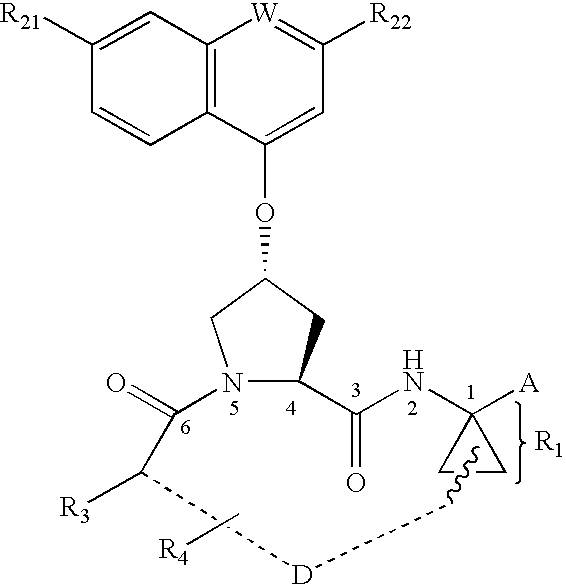Sulfur compounds as inhibitors of Hepatitis C virus NS3 serine protease
- Summary
- Abstract
- Description
- Claims
- Application Information
AI Technical Summary
Benefits of technology
Problems solved by technology
Method used
Image
Examples
preparation of specific examples
Example 108
[0209]
Steps 1 and 2:
Step 1:
[0210] KHMDS (200 ml of a 0.5M solution in toluene) was added, dropwise to a stirred solution of Methyl cyclohexanecarboxylate (11.1 g; 78 mmol) in anhydrous THF (200 ml), at −78 C under an atmosphere of nitrogen. When the addition was complete the reaction was maintained at this temperature for a further 0.5 h. before the addition of Benzyl Chloromethyl Ether (18.6 ml; 134 mmol). The reaction was allowed to warm to room temperature overnight and water (100 ml) was added. Aqueous work-up provided a residue which was purified by silica gel column chromatography using EtOAc; hexanes (1:10) as eluent to give the desired, impure, intermediate ether (14.98 g) as a colorless oil.
Step 2:
[0211] A black suspension of 10% Pd / C (0.5 g) and the aforementioned crude ether (4.1 g) in MeOH (80 ml) was exposed to an atmosphere of nitrogen (balloon) at room temp., overnight. The reaction was filtered through a pad of celite and the solid was washed thoro...
example 185
[0218]
[0219] Oxone (5.68 g) was dissolved in water (5 ml) and added to the carboxylic acid 185A (1.25 g) in methanol (5 ml) while cooled in an ice bath. The reaction mixture was allowed to warm to room temp., overnight. The volatiles were removed under reduced pressure and the residue was partitioned between methylene chloride and water. The aqueous phase was separated and extracted with methylene chloride (×2). The combined organic phases were dried and concentrated to yield the sulfone (185B; 1.10 g) as a white solid, used in subsequent procedures without purification.
Steps 2 and 3:
Step 2:
[0220] The benzyl carbamate (11.01; 0.16 g) was dissolved in TFA (7 ml) and dimethyl sulfide (1.78 ml) was added and the resulting mixture was allowed to stand at room temperature for a period of 3 h., before removing the volatiles under reduced pressure. This gave a residue which was used in step 3 below.
Step 3:
[0221] Triethylamine (111 ul) was added to a mixture of the residue from ste...
example 331
Preparative Example 331
Preparation of Intermediates of Formulas 331D and 331E for the Compound of Formula 331
[0252]
Step 1. Preparation of Compounds of Formulas 331B and 331C:
[0253] N-benzyl-4-methylbutanimine (prepared as described: Synthesis, 1985, 679) and tetrahydrothiophene 1,1-dioxide were reacted in the manner described in Example 336, except at −78° C., to afford compound 331A, which was hydrogenolyzed in the manner described in Example 336, except at a pressure of 1 atm. The crude product was chromatographed on silica gel, eluting with a gradient of EtOAc to 1:1 acetone-EtOAc to obtain first one racemic diastereomer: H1-NMR (CDCl3) δ 3.2 (m, 1H), 3.1-2.9 (m, 3H), 2.3-2.1 (m, 2H), 2.1-1.9 (m, 1H), 1.9-1.7 (m, 2H), 1.02 (d, 3H), 0.85 (d, 3H).
[0254] Further elution afforded the other racemic diastereomer: H1-NMR (CDCl3) δ 3.2 (m, 1H), 3.2-2.9 (m, 4H), 2.3-2.1 (m, 3H), 2.1-2.0 (m, 1H), 1.78 (sex., 1H), 0.96 (m, 6H).
Step 2. Preparation of Compounds of Formulas 331D and 331E...
PUM
| Property | Measurement | Unit |
|---|---|---|
| Composition | aaaaa | aaaaa |
| Structure | aaaaa | aaaaa |
| Antimicrobial properties | aaaaa | aaaaa |
Abstract
Description
Claims
Application Information
 Login to View More
Login to View More - R&D
- Intellectual Property
- Life Sciences
- Materials
- Tech Scout
- Unparalleled Data Quality
- Higher Quality Content
- 60% Fewer Hallucinations
Browse by: Latest US Patents, China's latest patents, Technical Efficacy Thesaurus, Application Domain, Technology Topic, Popular Technical Reports.
© 2025 PatSnap. All rights reserved.Legal|Privacy policy|Modern Slavery Act Transparency Statement|Sitemap|About US| Contact US: help@patsnap.com



